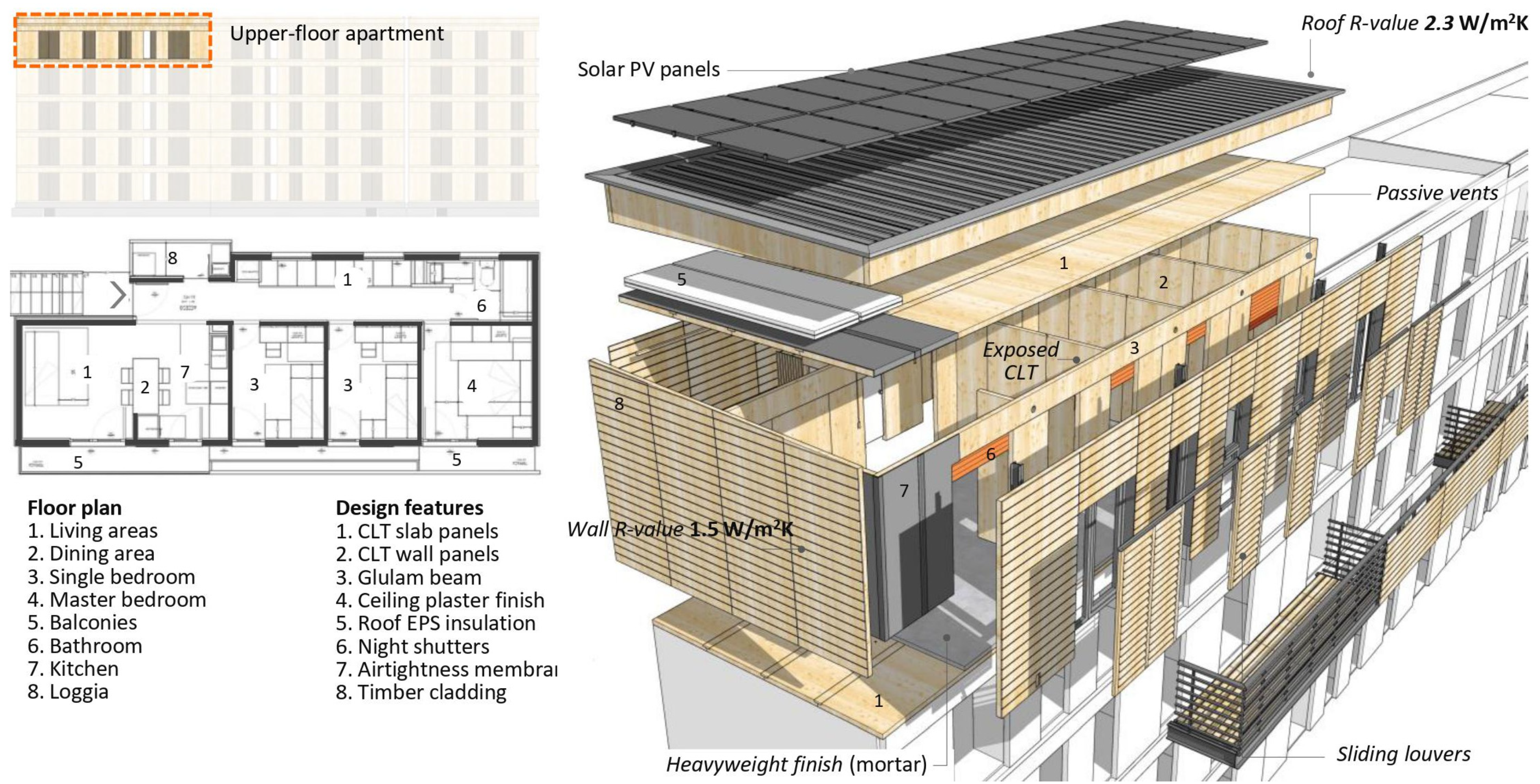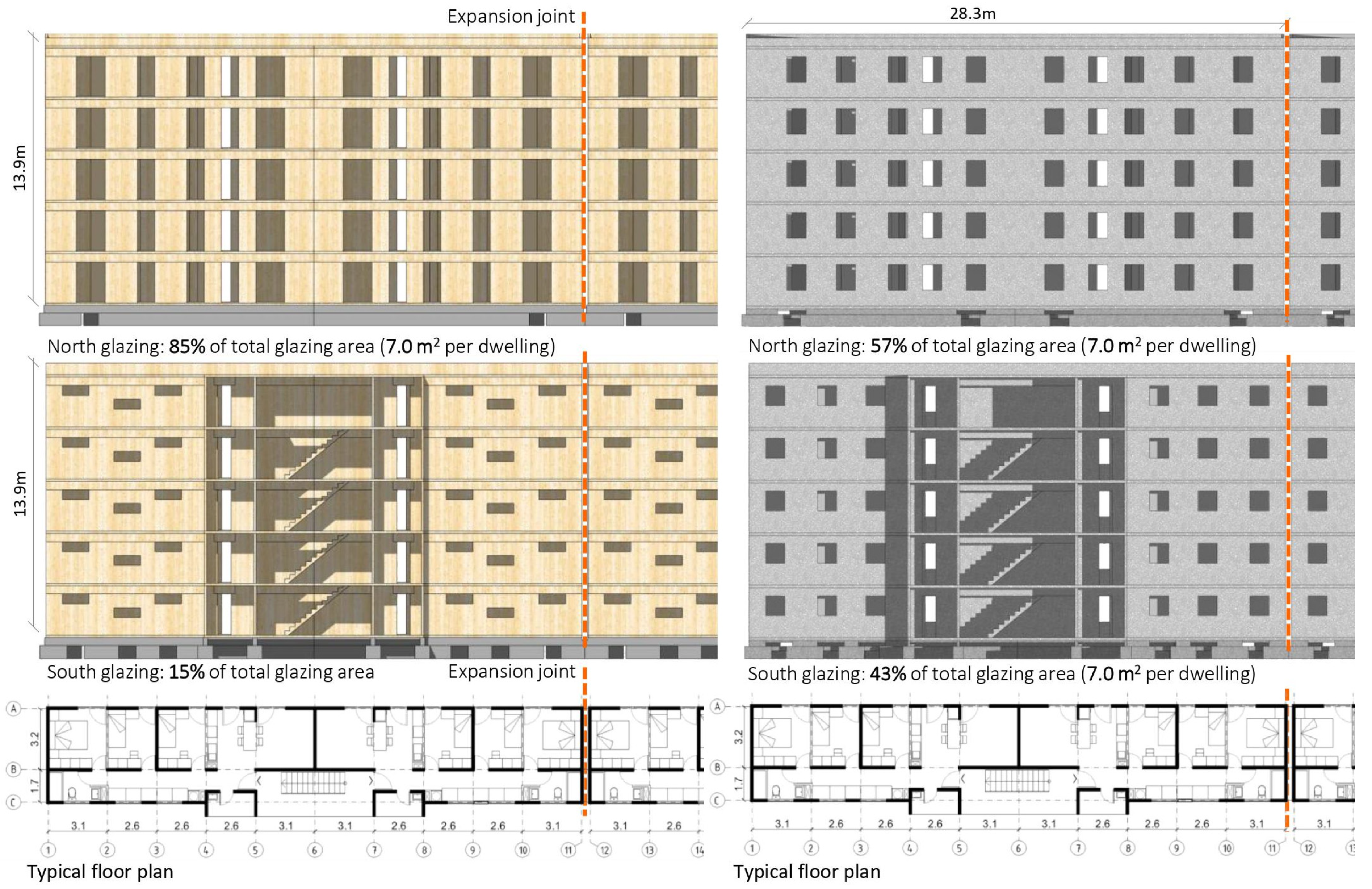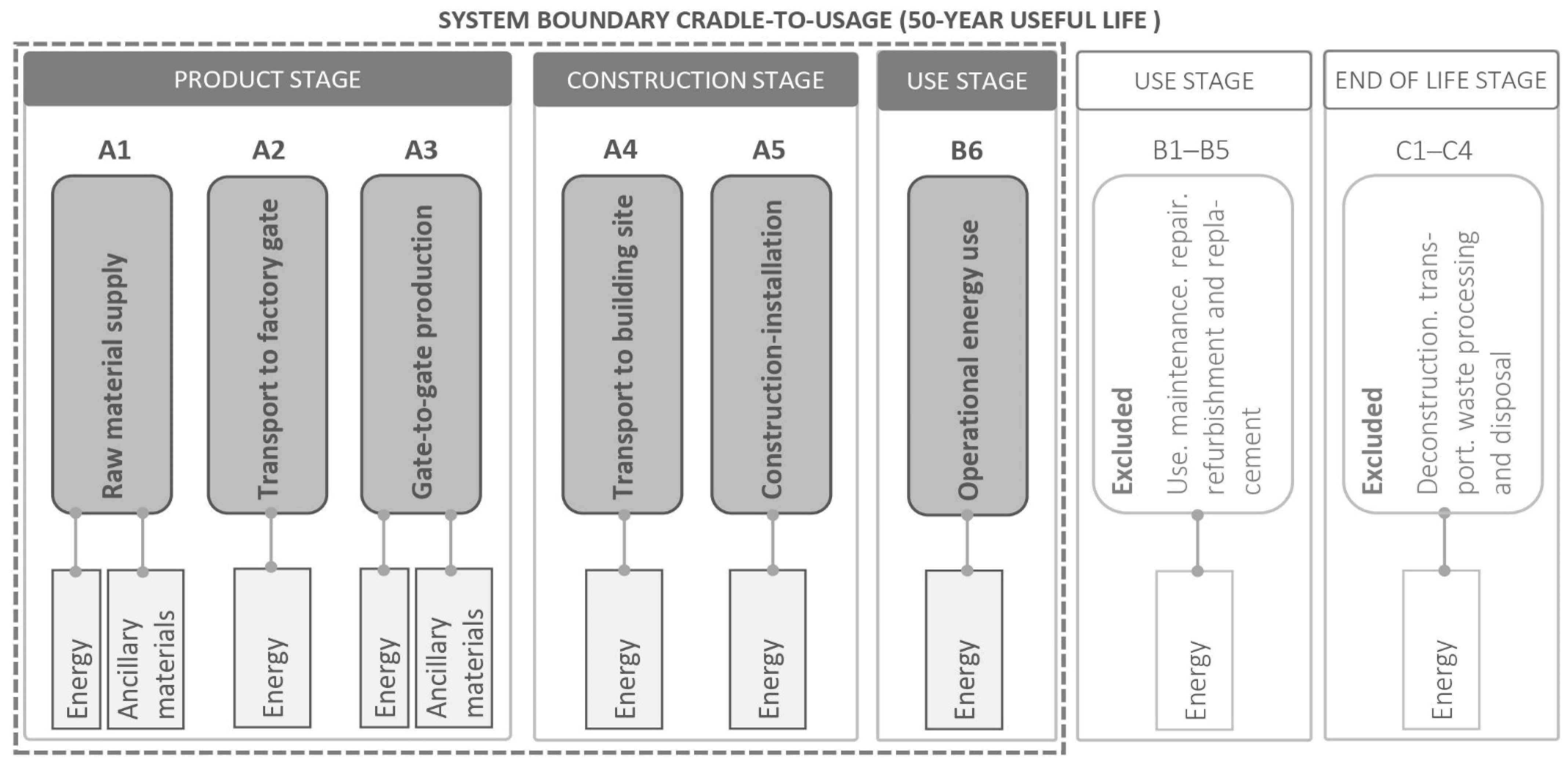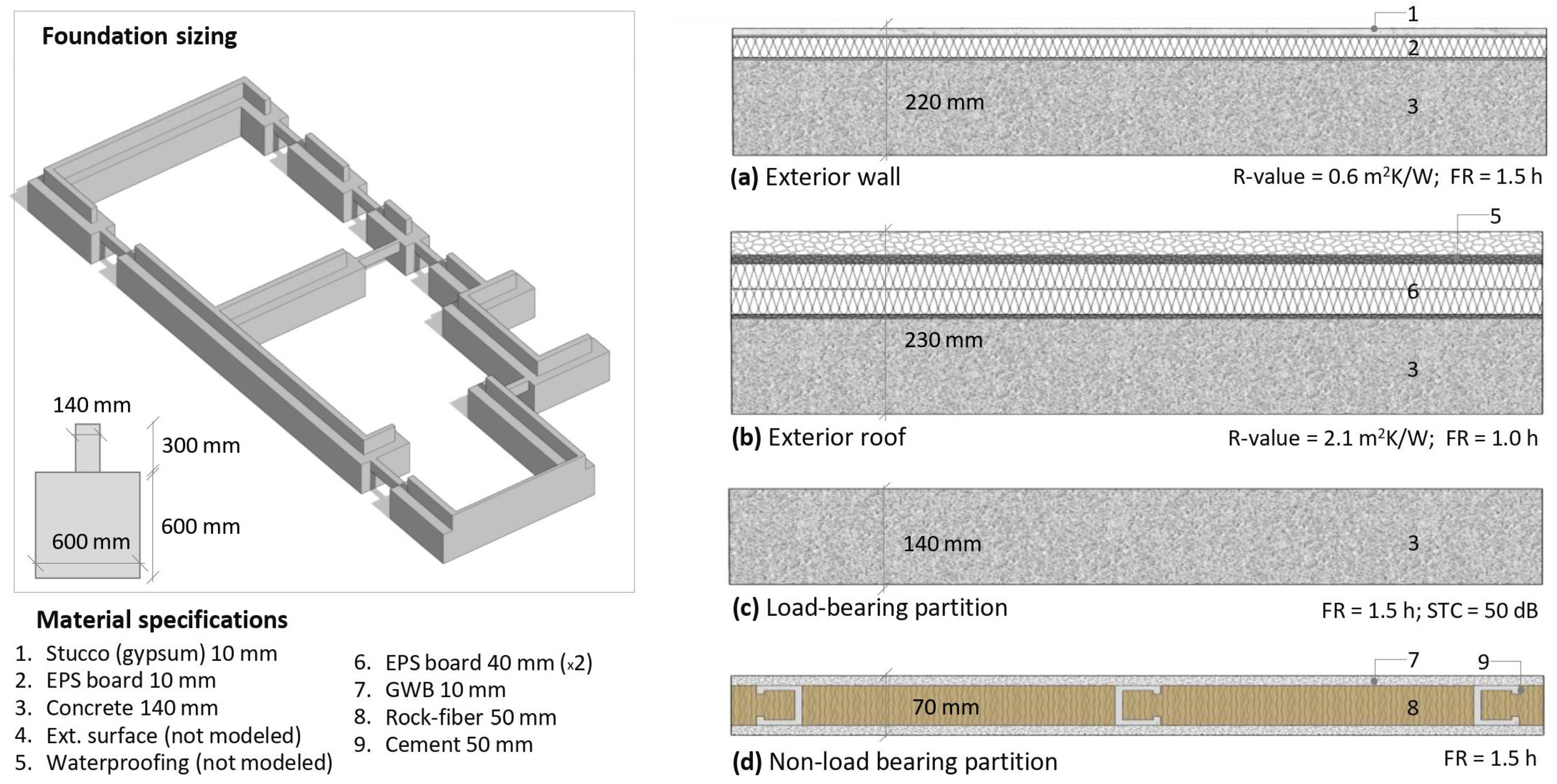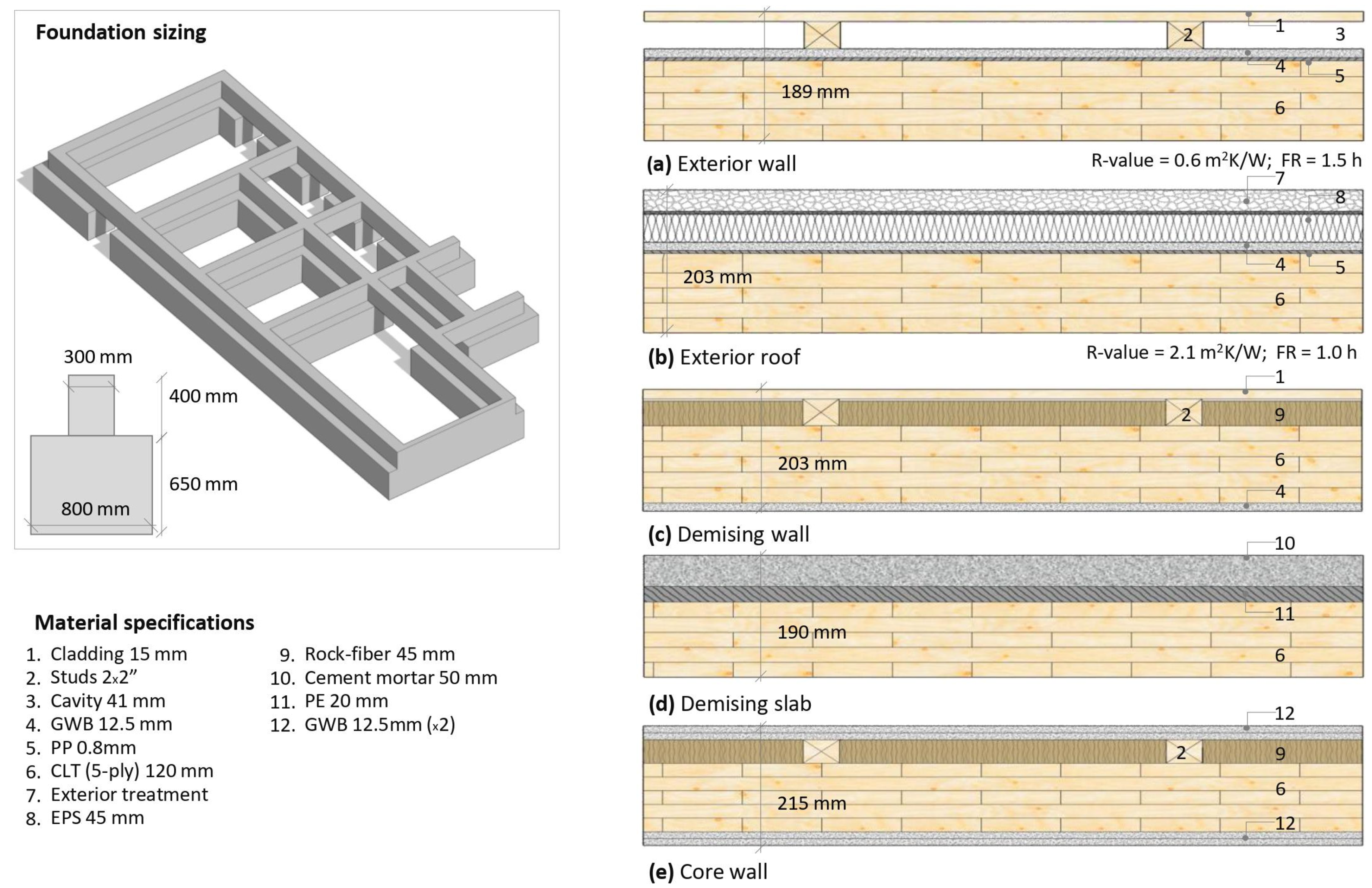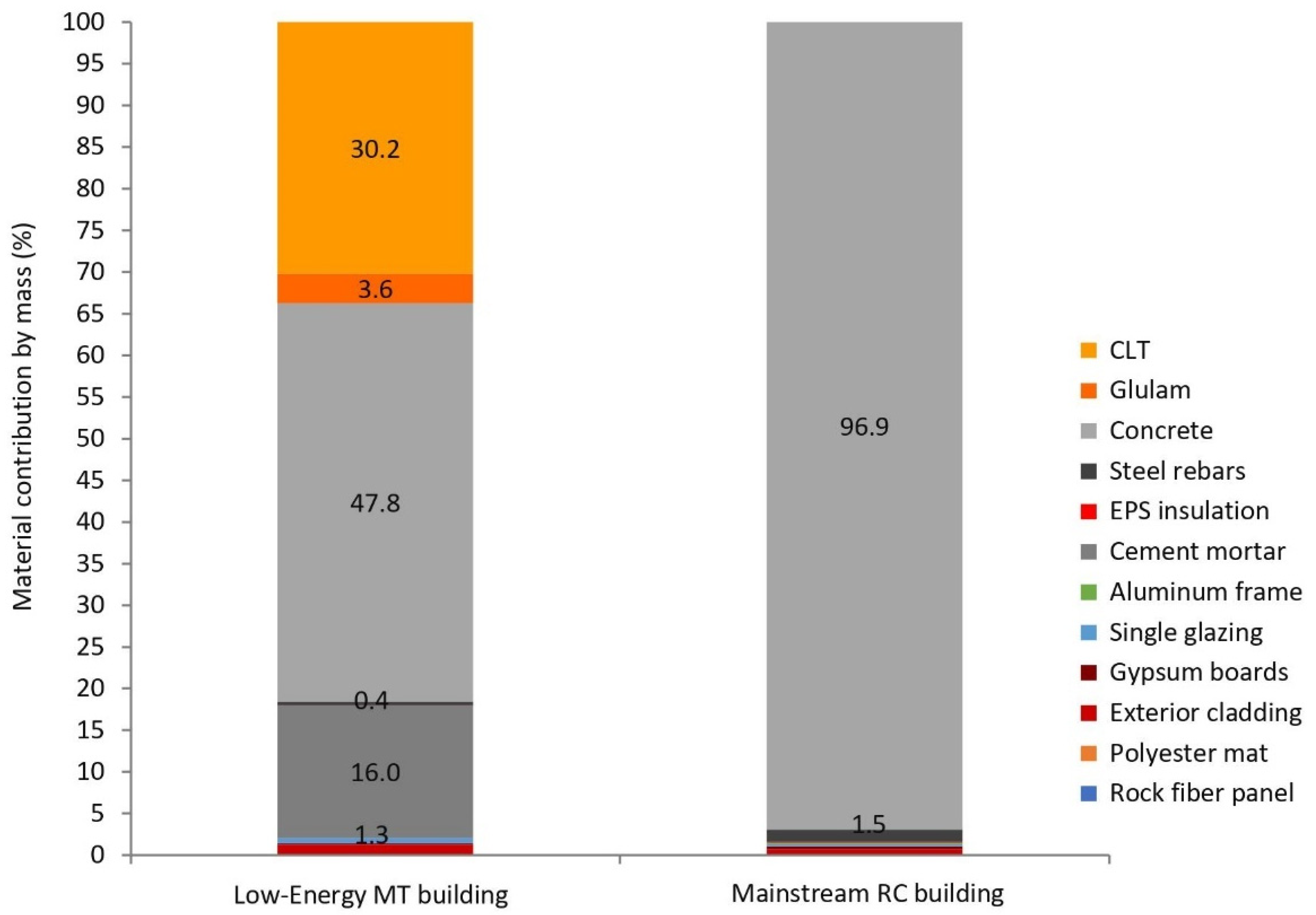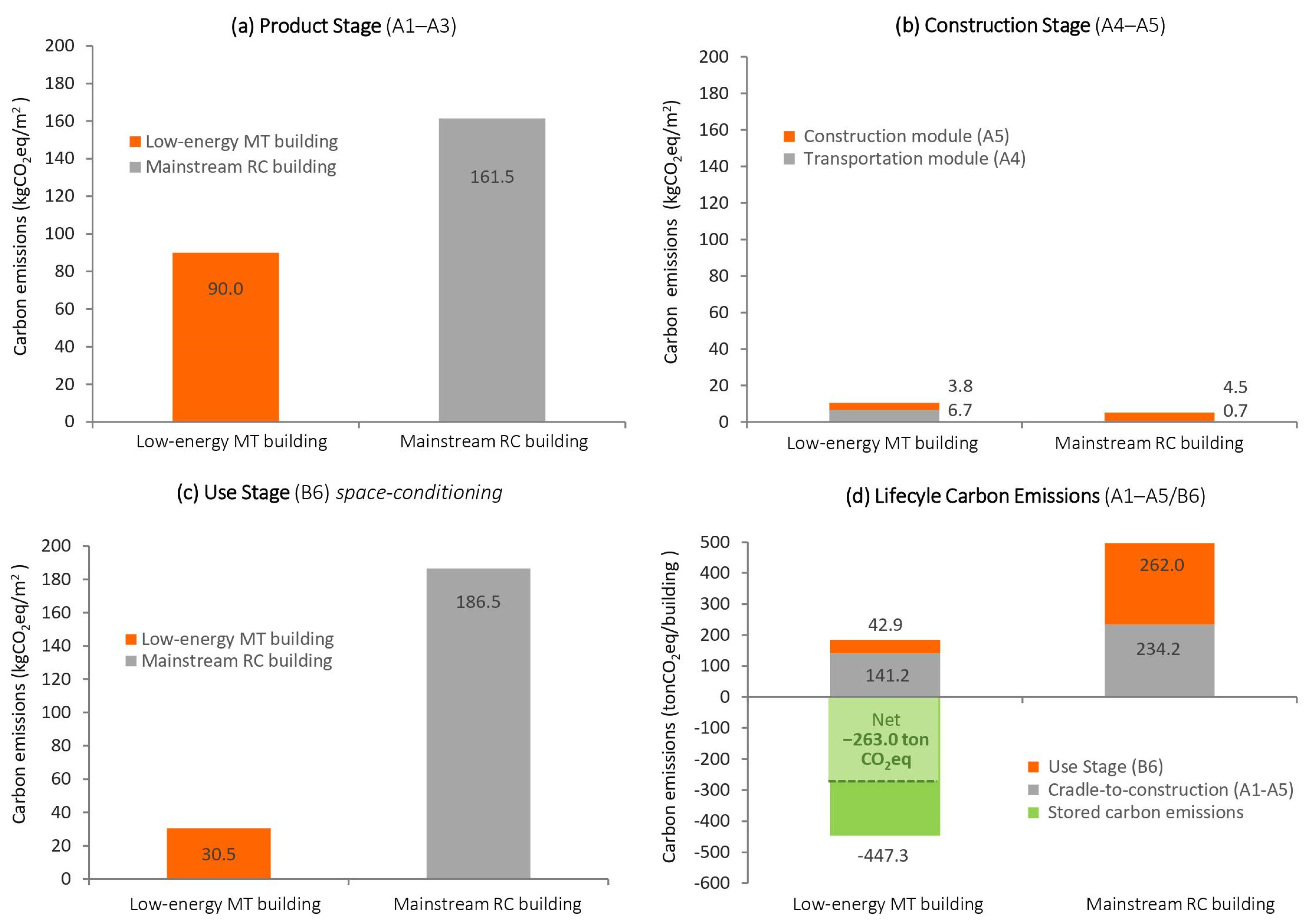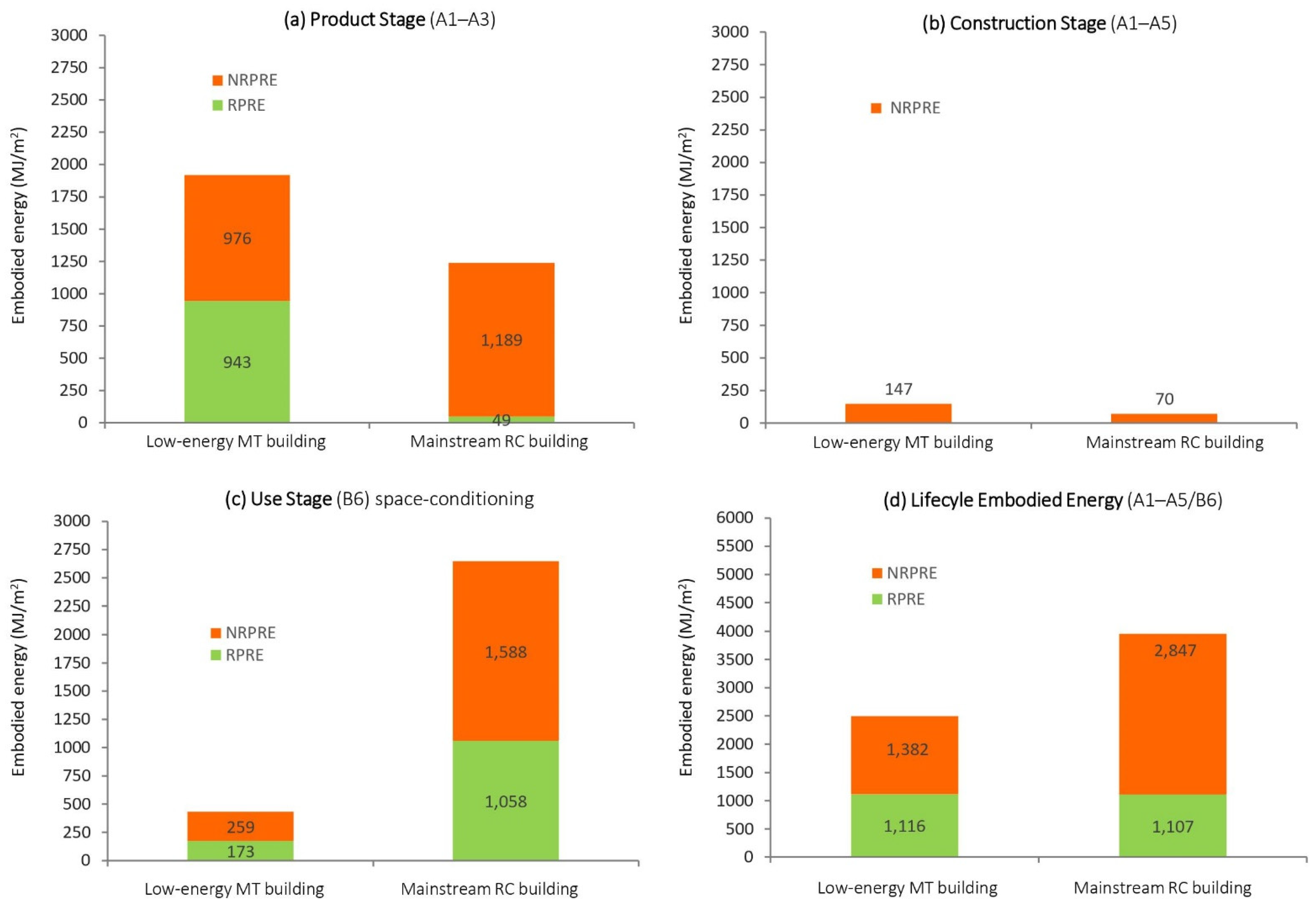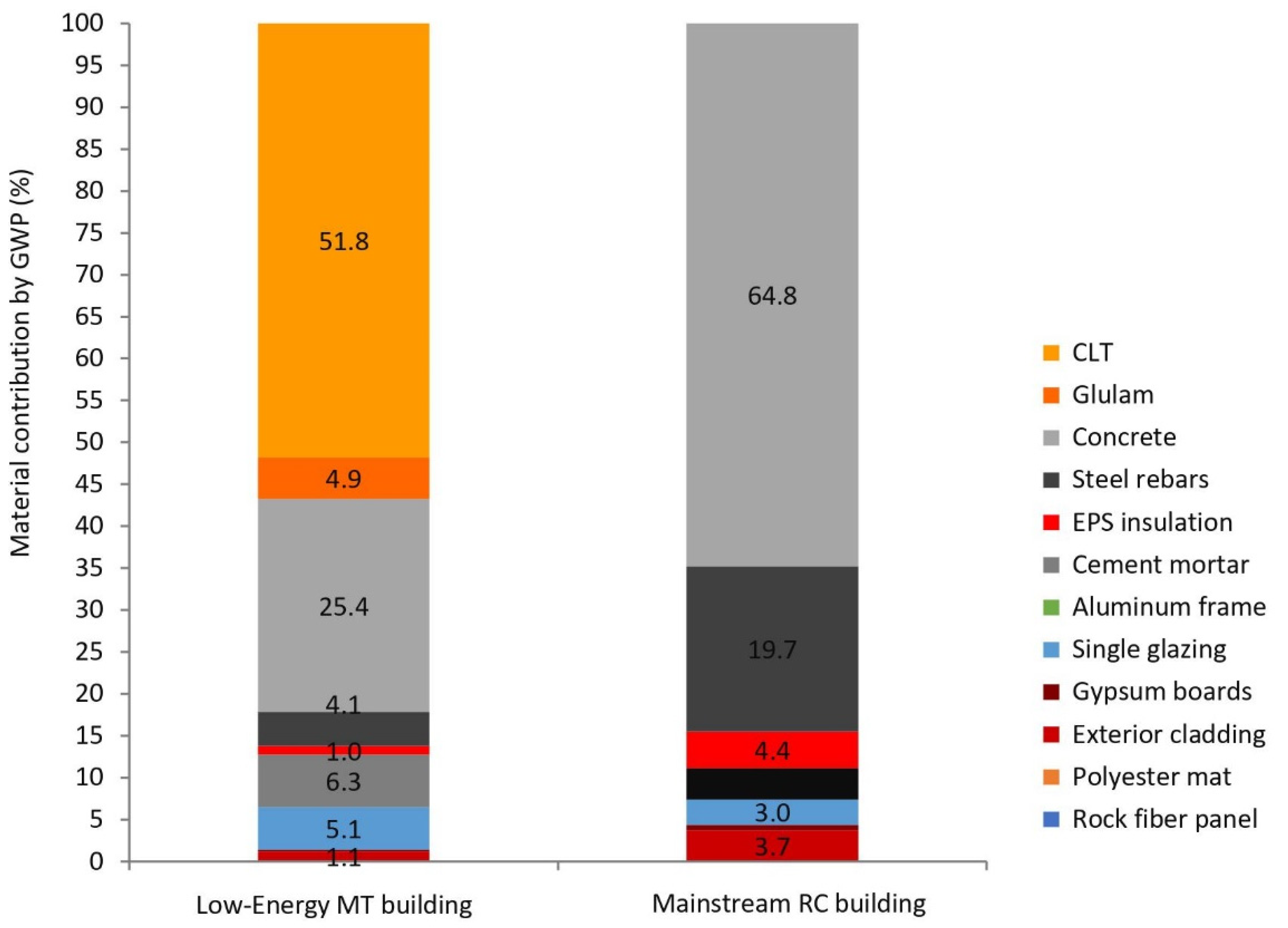1. Introduction
The use of sustainably sourced mass-timber technologies to build multistory residential buildings (mainly cross-laminated timber (CLT) and glue-laminated timber (glulam)) has the potential to mitigate global climate change and benefit developing economies [
1,
2,
3]. While it is well known that the building sector is responsible for about 40% of global carbon emissions [
4], there is a large body of scientific research showing that, compared to reinforced concrete (RC), mass-timber (MT) buildings can store large amounts of biogenic carbon, reduce the embodied carbon of building materials, and avoid useful life emissions from auxiliary space-conditioning energy [
5,
6,
7,
8]. In recognizing these advantages, large forest product exporters, such as China (CN), Brazil (BZ), and Chile (CL), are currently seeking synergies with their timber sector to tackle large housing deficits and meet carbon emission targets by 2050 [
9,
10,
11]. In Chile, since over 90% of new multistory constructions are RC apartment buildings [
12], the surge of a high-rise MT industry could lead to a transition towards decarbonizing the national construction sector.
The rapid global expansion of the MT industry, which has quintupled over the last decade, reaching a production of over three million cubic meters by 2019 [
13], has posed many research challenges to assess its long-term environmental impacts. Recent lifecycle assessments (LCA) comparing carbon emissions between MT and RC buildings in the US, Austria (AT), the UK, and CN have shown that through sustainable forestry practices, MT buildings could help offset most lifecycle emissions with per-square-meter carbon storage rates between 145 and 490 kg CO
2 eq [
2,
3,
14,
15], reduce emissions from cradle-to-construction by 35–47% [
1,
2,
3], and avoid emissions from space-conditioning energy by 30–40% over useful life [
5,
6]. These ranges are due to differences in local manufacturing, building codes, and construction practices that are just being acknowledged and, if not well understood, may lead to unforeseen adverse effects on greenhouse gas (GHG) emissions and global fossil fuel depletion [
1,
2]. Mass-timber production in Chile is low scale, has incipient CLT production, and leaves several gaps yet to be addressed regarding sourcing, manufacturing, and environmental performance.
Over two-thirds of primary energy use, greenhouse gases, and solid waste generated by the building sector in Chile comes from housing [
15,
16]. This is partly because 75% of new constructions are residential buildings, 100 thousand units per year [
12], and partly due to the thermal inefficiency of its existing housing stock leading to acute overconsumption of fuels for space heating, which accounts for over half of national residential energy use, an annual average of 4280 kWh per dwelling [
17]. Although the country extends over a wide range of latitudes (17–56° S), more than 90% of its population is concentrated in the mild climatic region of its central valley (32–43° S) [
18], where 98% of the country’s sawn timber is produced—8 million cubic meters yearly [
19]. Due to the mild climate and improved thermal performance of MT envelopes compared to mainstream cement and steel [
7], there is great potential for MT buildings to cut most useful life emissions. To date, the major constraints for MT construction in CL are stringent seismic codes and the lack of tested MT products and design guidelines to meet local standards, namely, to fulfill current code requirements for fire safety, soundproofing, and thermal insulation.
This study aims to bridge the existing knowledge gap regarding the carbon and energy impacts of sourcing, manufacturing, and space-conditioning of mass-timber buildings in central Chile (CCL). The study is part of a larger research effort led by the Nature Conservancy (TNC), a nonprofit environmental organization, that seeks to assess the impact of increased MT construction on global forest and carbon stocks [
20,
21]. Six cities were selected by the TNC project—Atlanta (US), Boston (US), Seattle (US), Santiago (CL), Beijing (CN), and Vienna (AT) [
21]. This paper reports the results of the first LCA performed on a mid-rise low-energy MT building in Santiago and compares it with an equivalent mainstream RC building, considering current national building codes [
22]. The objectives of the study are:
Perform a cradle-to-construction LCA of the low-energy mass-timber design;
Perform a cradle-to-construction LCA of a building with similar functionalities but constructed with reinforced concrete;
Assess the space conditioning performance of the buildings over useful life.
2. Case Study Building
The case study building selected for the LCA is a mid-rise social housing apartment block (
Figure 1) classified as type B2 according to the Chilean Ministry of Housing [
23]. The building is part of a large public multi-apartment development that would be built on an underused parking lot in downtown Santiago [
24]. The development, which was designed for a solar decathlon contest held in 2019 in Santiago [
25] by a Chilean architectural team of the TNC project, has six apartment blocks of 20 flats each, four large open courtyards, ground-floor facilities, and retail shops. Aiming to reduce lifecycle emissions, the design of the blocks was adapted to integrate locally sourced prefabricated CLT designs and passive envelope features [
26]. As shown in
Figure 1, to simplify the building modeling, material quantifications were performed on a base module of 10 flats separated from the rest of the block by a structural expansion joint. As is common for social housing in CL, the height of the blocks was set at five stories, the maximum allowed by code without incurring additional expenses for mandatory elevators [
27].
The MT and RC buildings were both modeled to conform to Chilean standards (NCh) and regulations set by the General Construction and Urbanism Ordinance (OGUC in Spa-nish) [
27]. A functionally equivalent approach was adopted to quantify building materials by which components that were comparable between the two building types were not considered (e.g., windows, frames, railings, etc.). Non-structural elements, such as aesthetics and interior finishing, may differ between the two buildings. However, MT and RC elements requiring additional materials to meet minimum code standards, such as thermal insulation, acoustic barriers, and fire-retardants, were modeled. To account for emissions from space-conditioning energy over useful life, it was assumed that the MT apartment building would feature passive designs proposed for the solar decathlon contest, summarized in the axonometric shown in
Figure 2, whereas the RC building would keep mainstream design features complying with minimum national OGUC regulations.
Although no particular site was considered for the LCA analysis, for structural design purposes, specific seismic demand and the static and dynamic soil-bearing capacities were assumed. Dynamic load characteristics were drawn from seismic hazard zone II, a region of intermediate seismicity according to Chilean standard NCh-433: Earthquake Resistant Design of Buildings [
28]. Soil mechanical properties were classified as stiff, drawn from soil class C, Supreme Decree DS-61: Seismic Soil Categories [
29]. Both design characteristics are representative of most built-up areas in the Santiago basin [
30]. It should be noted that both zone II and soil class C have restrictive seismic design criteria comparable the most stringent site classes of US standards (classes D and F [
30]). If, unlike the assumptions made here, a more restrictive hazard zone or soil class was the case, the size of structural members will increase more on the MT building than on the RC building requiring greater concrete foundations and lateral load reinforcement.
Figure 2.
Exploded view and floor plan of the MT module built at the technological park [
31].
Figure 2.
Exploded view and floor plan of the MT module built at the technological park [
31].
To facilitate comparison, the MT and RC buildings were assumed to have the same overall dimensions, that is, structural grid and floor heights. As shown in
Figure 1, the 20-unit apartment block modeled for the LCA analysis has a total habitable floor area of 1405 m
2, with a footprint of roughly 28 m × 5 m and 13.9 m overall height. The structural walls are spaced at around 3 m in each direction. The core is 2 m × 6 m. Floor-to-floor heights are limited to 3.2 m on the first floor and 2.66 m on the upper floors. All exterior circulation areas and distances between stairways and entries were designed as per OGUC code (Art. 4.2.1 General Safety Conditions [
27]). The specifications and structural dimensions of MT members were informed by a pilot apartment module (
Figure 2) built in 2021 as part of the framework of this project at the Technological Park of the University of Chile [
31].
4. Building Code Assumptions
The criterion for building materials’ specification was to meet national codes with locally available mainstream products. To this end, detailed specifications were drawn from tested product assemblies provided by the Chilean Ministry of Housing and Urbanism (MINVU in Spanish), specifically for fire safety (E-12 [
43]), soundproofing (E-14 [
43]), and space conditioning (E-8 [
43]). When no tested assemblies were available for MT construction, equivalent product specifications were taken from international guidelines and adapted accordingly. Material specifications and code-compliant standards are detailed in
Figure 4 and
Figure 5.
Fire resistance: National fire safety standards for 5–6 story buildings (Type B under OGUC [
43]) require minimum fire-resistive ratings of 1.0 h for roofs (b), 1.5 h for demising and load-bearing walls (c/f) and slabs (d), and 2 h for staircase walls (e). As per MINVU E-12 guidelines, no additional fire-retardant materials were required for the RC building. For the MT building (
Figure 4), following specifications from northern Europe CLT pine [
44], almost all assembly categories required additional fire protection, assuming gypsum wall boards (GWBs) and rock fiber as the requisite non-combustible materials.
Soundproofing: OGUC allows a maximum sound transmittance coefficient (STC) of 45 dB for demising walls and slabs (
Figure 5c,d) and a minimum impact insulation coefficient (ICC) of 75 dB for demising slabs (
Figure 5d). As per MINVU E-14, no additional soundproofing materials were required for the concrete building. Since no acoustic tests had been conducted for Chilean CLT products, reference assemblies were drawn from a recently published acoustical report by WoodWorks [
45]. To comply with standards for demising CLT walls, a cavity space and two-layer GWBs were added on both ends (
Figure 5c). For the CLT slabs, a cement mortar topping with a polyester sound-deadening mat underneath was used to meet the requisite soundproofing assembly (
Figure 5d).
Thermal performance: Minimum admissible thermal resistances for Santiago (Zone D) are 0.5 m
2k/W for exterior walls and 2.1 m
2k/W for the roof [
46]. For the RC building, a typical concrete wall assembly was used, including a 10 mm expanded polystyrene EPS board and gypsum plaster or stucco as exterior finish (
Figure 4a). The same solution was used for the roof, which required a thicker EPS board of 80 mm (
Figure 4b). For the MT building, no additional insulation was required for external walls and only 45-mm EPS was required for the roof (
Figure 4a,b). The density and conductivity of MT elements, seen in
Appendix A (
Table A3), were drawn from results of laboratory tests undertaken as part of this study at the laboratory of mechanical engineering at the University of Santiago.
Structural design: Given that Chilean seismic codes are strict [
30], additional consideration was given to meeting statutory resistance criteria by performing spectral modal analysis with ETABS v. 18 engineering software [
43]. As a result of traditional construction practice and local code compliance, multistory buildings in CL generally have short floor spans and several load-bearing walls [
30]. Unlike other countries with similar seismicity, such as the US or New Zealand (NZ), the design of high-rise buildings relies on redundant configurations and stiff framing to overcome the low drift limits imposed by standard NCh-433 (i.e., a maximum drift limit of 0.002 h
s, compared to 0.02 h
s (US) and 0.015 h
s (NZ) [
47]). For this study, the seismic resistance of the MT building is provided by a dense grid of CLT walls confined with glulam beams and additional RC foundation reinforcement. Further shear resistance is provided by CLT steel connectors, such as typical hold-down angle brackets and bolts. No additional steel framing or buckling-restrained braces were specified as per structural design.
For dimensioning structural elements, uniform design criteria were applied to both buildings in compliance with national standards for seismic action, NCh-433 [
28], soil classification, DS-61 [
29], and permanent and live loads, NCh-1537 [
43]. For the RC building, the assumed compressive strength of concrete was 25 MPa, and the ultimate and yield strength of reinforcing steel rebars 630 MPa and 420 MPa (grade A630-420H [
43]). For the MT building, structural CLT and glulam components were assumed to be machine-strength graded
Pinus radiata with a bending stress of 24 MPa, which is timber class C-24, according to Chilean standards [
43]. Since CLT panel steel connectors were not modeled, they were assumed to equal 2% of all reinforcing steel rebars used for the foundations of the MT building. As per standard NCh1537 [
43], additional dead loads of 150 kg/m
2 and live loads of 200 kg/m
2 were assumed in private areas, 300 kg/m
2 for common areas, and 100 kg/m
2 for the roof. The seismic mass of the buildings was calculated considering 100% of the dead loads and 25% of live loads. See
Appendix A (
Table A5) for detailed input parameters and the results of the spectral modal analysis.
6. Discussion
Based on LCA results which show that for a given location in Santiago (CCL), mass-timber has lower embodied emissions than mainstream concrete and steel, relevant design implications can be drawn on how to improve the carbon footprint of MT buildings. To examine these design issues,
Figure 9 shows a GWP contribution analysis by material assembly. As can be seen for the MT design the large GWP share of the mass-timber structure (56%) could be reduced through carefully weighing losses in carbon storage capacity by substituting load-bearing CLT walls with glulam columns and beams [
54]. Further savings can be made by reducing the GWP share of the concrete foundations (30%) distributing lateral loads on above-grade structures through either adding a concrete ground floor and concrete core walls [
54] and/or hybrid steel-timber frames [
55]. On sites with the same or more stringent seismic provisions than those assumed in this study which will yield larger emissions, an advisable choice to reduce seismic loads on the foundations would be to increase the compactness of the building shape.
Other design measures for reducing the embodied emissions of materials include exploring alternative assemblies to meet code compliance standards. As seen in
Figure 9 after the concrete foundations, the largest GWP share for the MT design was the cement mortar topping (6.3%) used to meet the fire and acoustic ratings of CLT slabs which can be substituted using multiple layers of gypsum, wood fiber, and/or stone wool boards [
56]. Although a more significant effect will be seen on buildings with 6 stories or more where national fire ratings are more stringent [
26], the GWP share of non-combustible gypsum and rock-fiber (1.2%) could be lowered by adding a charring layer to CLT and glulam [
57]. For non-load-bearing walls where minimum fire ratings are 0.25–0.5 h [
26], an interesting alternative would be replacing aluminum frame with 60 mm thick CLT partitions. For any of the outlined choices, there should be careful consideration to weigh the embodied emissions of all substitute materials required to meet equivalent compliance.
With regard to space-conditioning, the LCA results also show that while the passive designs of the MT building increased its embodied emissions, their contribution to reduce useful life emissions were significantly much greater. In terms of additional materials, the embodied emissions of the improved design features applied to the MT building sum up 7.8 kg CO2 eq/m2 whereas over useful life, they help reducing by over 37 kg CO2 eq/m2 emissions from space-conditioning energy use. Since again the largest GWP is the cement mortar topping (5.6 kg CO2 eq/m2), further efforts should be placed in finding alternatives to increase the thermal capacity of mass-timber envelopes. Interestingly, compared to the concrete building, the most influential contributions in displacing auxiliary space-conditioning demands were the distribution of glazing areas (34%) and the inherent lower thermal transmittance of the mass-timber envelope (23%). Future work should be undertaken to provide a more comprehensive overview of the performance of MT buildings, including variations in indoor temperatures, occupant comfort, and household operation.
Overall, the results show that provided that further efforts are made to address end-of-life waste management options, the carbon stored in the MT building could help offset emissions of cradle-to-construction and space-conditioning energy use, leaving scope to address other domestic energy end-uses. As shown in
Figure 7, until end-of-life, the MT building stores 318 kg CO
2 eq/m
2 which adding emissions from cradle-to-construction (101 kg CO
2 eq/m
2) and space-conditioning energy use (31 kg CO
2 eq/m
2) leaves a total negative net of 186 kg CO
2 eq/m
2 (A1–A5/B6). As an indication, the residual annual energy use of an average household in the MRS is roughly 4000 kWh (including LPG for water heating and cooking and electricity [
17]) the equivalent of nearly 1000 kg CO
2 eq/m
2 (50-yr). As specified for the MT design (
Figure 2), the installation of on-grid solar photovoltaics would help offset this total with four panels of 275 W per household a target that can be balanced through current subsidy schemes (MINEN [
42]). On the other hand, to avoid releasing the stored carbon after end of life CLT and glulam components can be reused or combusted as a substitute of fossil fuel where previous studies have shown carbon retention rates of 85–90% [
52,
53]. To make definitive comparisons, future work should delve into evaluating other use modules and end-of-life scenarios.
7. Conclusions
A lifecycle analysis was performed to investigate the carbon and energy implications of manufacturing and using a low-energy mass-timber residential building and compare it against those of a mainstream concrete building in central Chile. The system boundary comprised sourcing and processing of radiata pine lumber, local manufacturing, and on-site installation of mass-timber products, transportation, and energy use for space-conditioning over useful life. For both buildings, reinforced concrete represented the largest contribution by mass. In the concrete design, reinforced concrete accounted for 97% of the total building mass. In the timber building, mass-timber materials such as CLT and glulam represented 30% and 4%, respectively. Global warming potentials for the mass-timber and concrete buildings were estimated at 101 and 167 kg of CO2 eq/m2, respectively. A 40% reduction in equivalent emissions was estimated when the reinforced concrete structure was replaced by CLT and glulam products.
By considering wood as carbon sink, until-of-life phases where significant emissions could be released due to waste disposal choices, the usage of mass-timber allows achieving a total negative net of 306 tons of CO2 eq/building, decreasing emissions by 131% when compared to an equivalent concrete building. From cradle-to-usage, the embodied energy of the mass-timber building was 37% lower than that of the concrete building option, with a share of 45% and 27% in renewable energy, respectively. Furthermore, over the lifespans of the buildings, the accumulated emissions due to space-conditioning energy usage were as much as 83% lower for the mass-timber building design (30.5 tons CO2 eq/m2) than that of the mainstream concrete building (186.5 tons CO2 eq/m2). Finally, the use of mass-timber products such as CLT and glulam in a conventional five-story residential building located in Santiago, central Chile, generates potential benefits to the environment, decreasing the emissions of GWP when used to substitute concrete.
